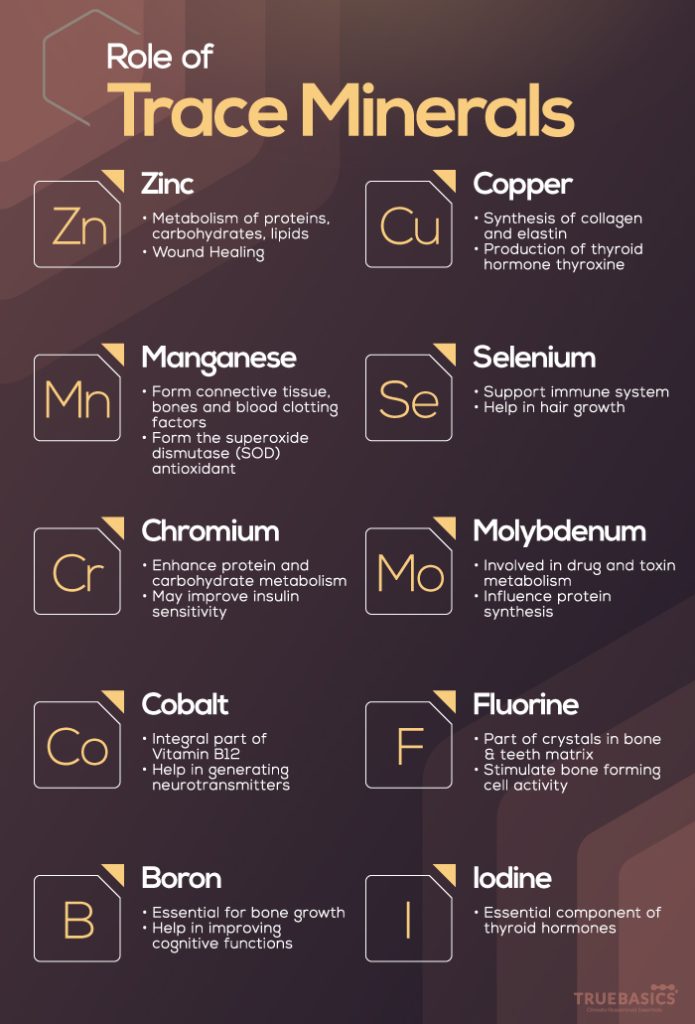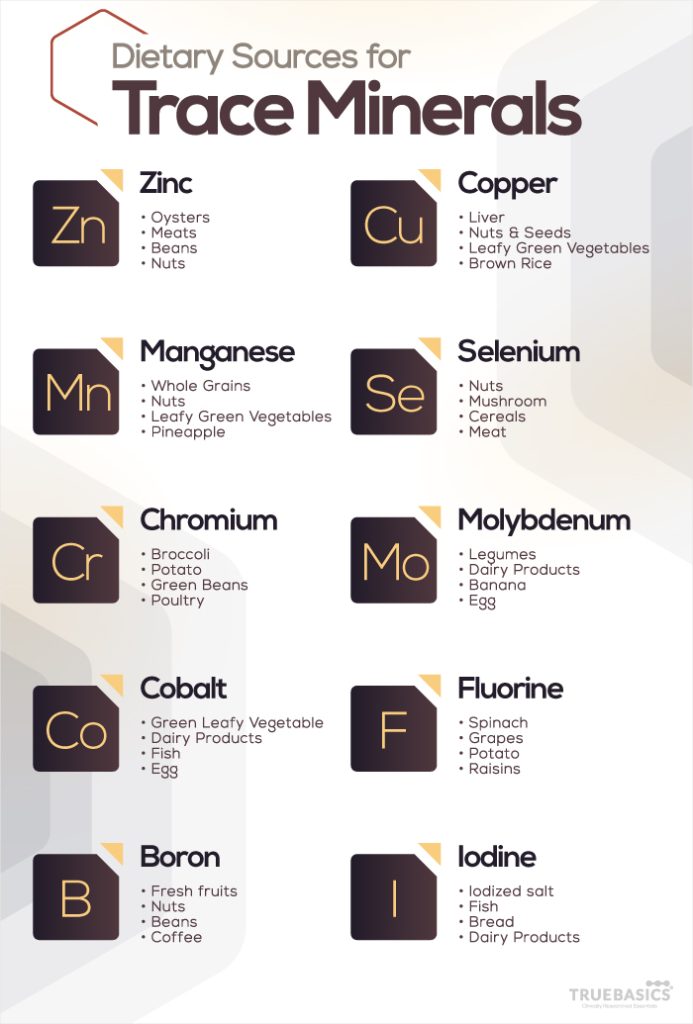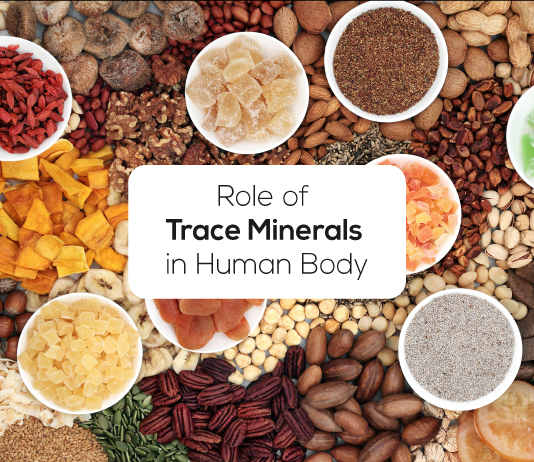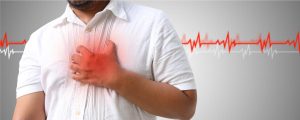Trace minerals are minerals that are required in a minute quantity but play a vital role in the growth, development, and function of the body. Zinc (Zn), Copper (Cu), Selenium (Se), Chromium (Cr), Cobalt (Co), Iodine (I), Manganese (Mn), Fluorine (F), Boron (B), and Molybdenum (Mo) [1] are the trace mineral which play multiple vital roles in the human body.
Role of Trace Minerals?
The trace minerals are utilized by the body in small quantities, but they play an essential role in biological activities. They primarily act as catalysts for enzyme actions while some metallic ions take part in oxidation-reduction reactions involved in energy metabolism [2]. Some trace minerals also play important roles in body structure.
Wondering how do these trace minerals help our body? Dive right in to know the key roles these minerals play –
1. Zinc (Zn)
Zn is an essential trace element that functions as a cofactor for certain enzymes involved in metabolism and cell growth.
Function
- As a component of nearly 300 specific enzymes, Zn is involved in the metabolism of proteins, carbohydrates, lipids, and energy production.
- It is also an essential trace element for a healthy immune system and plays an important role in wound healing.
- Zinc is also required for insulin activity.
RDA: 12 mg/day for men and 10 mg/day for women, 12 mg/day for pregnant and lactating women.
Deficiency
Zn deficiency may occur due to insufficient dietary intake. Zn deficiency may cause impaired immune function, hair loss, delayed sexual maturation, impotence, and eye and skin lesions. Delayed healing of wounds, taste abnormalities and mental lethargy can also occur [1].
Food Sources: Wheat, brown rice, soybeans, peanuts, cashews, meat, eggs, milk, yogurt, walnut, and almonds are good sources of Zinc.
2. Copper (Cu)
Copper is the 3rd most abundant trace element with only 75–100 mg of the total amount in the human body [3]. Copper is present in almost every tissue of the body and is stored chiefly in the liver along with the brain, heart, kidney, and muscles. A significant number of metabolic enzymes require Copper to function properly.
Function
- Copper containing enzyme cytochrome c oxidase plays a vital role in energy production during aerobic respiration.
- It is also a component of lysyl oxidase which takes part in the synthesis of collagen and elastin. Therefore, Copper is essential for maintaining the strength of the skin, blood vessels, and epithelial and connective tissue throughout the body.
- Copper-containing enzyme tyrosinase converts tyrosine to melanin which gives color to the skin.
- Copper is also required to produce the thyroid hormone thyroxine.
RDA: 1.7 mg/day
Deficiency
The symptoms of Copper deficiency are hypopigmentation of hair and skin, abnormal bone formation with skeletal fragility and osteoporosis, lowered immunity, and vascular aberrations [4].
Molybdenum has an antagonistic effect against Copper; thus, high concentrations of Molybdenum can reduce Copper absorption and subsequently lead to Copper deficiency [5].
Food Sources: Barley, brown rice, wheat bread, beans, cashew, almond, potatoes, organ meats (kidney, liver), dark leafy greens vegetables.
3. Manganese (Mn)
Manganese is a trace mineral that is present in tiny amounts and the average human body contains about 12 mg of Manganese. About 43% of it is found in the skeletal system, with the rest occurring in soft tissues including the liver, pancreas, kidneys, brain, and central nervous system.
Function
- Manganese helps the body to form connective tissue, bones, blood-clotting factors, and sex hormones.
- It plays a role in fat and carbohydrate metabolism, calcium absorption, and blood sugar regulation.
- Manganese is also necessary for normal brain and nerve function. It is a component of the antioxidant SOD (superoxide dismutase), which helps fight free radicals.
RDA: 4 mg/day
Deficiency
Deficiency of Mn in the body may cause hypercholesterolemia, impaired glucose tolerance, changes in hair color, skeletal abnormalities, infertility, deafness, and impaired synthesis of Vitamin K-dependent clotting factors.
Food Sources: Whole grains such as brown rice, almond, walnuts, legumes, pineapples, tea, leafy greens vegetables, sweet potatoes, and beets1.
4. Selenium
Selenium (Se) is an essential trace element. The Selenium content in the human body is about 13-20 mg. Selenium containing protein also known as seleno-protein carries out various functions in normal health and metabolism.
Function
- Glutathione peroxidase (G-Px), a selenoprotein, is an antioxidant that protects the body from the damaging effect of free radicals. Its low levels in the human body have been linked to increased risk of various diseases, such as cancer and heart disease.
- Selenium is important for a healthy immune system, where it enhances T-lymphocyte immune responses.
- Studied have also established a relationship between low blood levels of Selenium and increased cardiovascular disease mortality [6].
RDA: 40 mcg/day
Deficiency
Selenium deficiency is rare in healthy humans. Selenium deficiency may cause myalgia and whitening of the nail bed.
Care must be taken in consuming large amounts of Selenium as it is toxic if taken in excess amounts.
Food Sources: Grains, meat, poultry, fish, and eggs are rich sources of Selenium
5. Chromium
Chromium is an essential trace element that can improve insulin sensitivity and enhance protein, carbohydrate, and lipid metabolism.
Function
- The biological function of Chromium is mainly associated with insulin function. Inorganic Chromium compounds display little or no insulin potentiating activity but upon conversion to organic Chromium complexes acquire significant insulin potentiating activity. Chromium picolinate is one such example of organic Chromium.
RDA: 50 mcg/day
Deficiency
Reports of actual Chromium deficiency in humans are rare. Chromium deficiency can cause a diabetic-like state due to impaired body’s ability to use glucose. Weakness and fatigue may occur in Chromium deficiency due to the inability of the body to utilize glucose for energy[7]. Diabetics, pregnant women, and the elderly are especially at risk of Chromium deficiency leading to impaired insulin function that may cause diabetes and heart diseases [8],[9],[10].
Food Sources: Broccoli, potatoes, green beans, beef, poultry, fruits including apples and bananas are good sources of Chromium.

6. Molybdenum
Molybdenum is a component of various enzymes that influences protein synthesis and growth of the body. Molybdenum is important for the functioning of enzymes involved in the metabolization of drugs and toxins.
Function
- Molybdenum acts as cofactor for 4 key enzymes – sulfite oxidase that converts sulfite to sulfate and prevents large buildup of sulfites in the body, aldehyde oxidase which breaks down the toxic aldehydes, xanthine oxidase that converts xanthine to uric acid breaking down unused DNA and Mitochondrial amidoxime reducing component (mARC) which is thought to remove toxic byproducts [11].
RDA: 45 mcg/day
Deficiency
Molybdenum deficiency is rare in a healthy human body as Molybdenum is amply available in common food sources.
Food Sources: Black-eyed peas, beef liver, yogurt, milk, banana, chicken, egg, and spinach.
7. Cobalt
The adult human body contains approximately 1 mg of Cobalt, 85% of which is in the form of Vitamin B12.
Function
- Cobalt is the central part of Vitamin B12 chemical structure which plays a critical role in the formation of erythrocytes (red blood cells). Apart from red blood cell production, Vitamin B12 also plays a significant role in nerve repair and regeneration.
- Cobalt also plays an integral role in generating neurotransmitters, which are requisite for the proper operation of an organism.
Deficiency
The deficiency of Cobalt is strongly related to disturbances in Vitamin B12 synthesis resulting in anemia and peripheral neuropathy.
Food Sources: Green leafy vegetables, dairy products, organ meat, egg, milk, and fish.
8. Fluorine
Fluorine makes a negligible part of body weight and enters the system principally through drinking water.
Function
- Fluorine is present as fluorapatite crystals in the matrix of bone and teeth.
- It is also believed that fluoride, in combination with calcium, improves bone formation by stimulating osteoblastic (bone-forming cell) activity.
Deficiency
Low levels of fluoride in drinking water have been associated with dental decay.
Food Sources: Drinking water either fluoridated or naturally containing fluoride [12]. Dietary sources of Fluorine include spinach, grapes, potato, and raisins.
9. Boron
Boron plays important roles in metabolism that render it necessary for human health.
Function
- Boron is essential for the growth and maintenance of bone.
- It raises the levels of antioxidant enzymes, such as superoxide dismutase (SOD) and glutathione peroxidase that protects from the damaging effect of free radicals.
- It improves wound healing by stimulating specific enzymes like elastase, collagenase, and alkaline phosphatase that play a critical role in wound healing.
- Boron is also found to improve the brain’s electrical activity and cognitive function in the elders [13].
Deficiency
Studies suggest a Boron deficiency can increase the risk of arthritis development [14].
Food Sources: Fresh vegetables and fruits, avocado, apples, coffee, nuts, beans, peas are commonly found sources of Boron.
10. Iodine
Iodine is a vital trace element required at all stages of life especially during developmental years.
Function
- Iodine is an essential component of thyroid hormones, that is, tetraiodothyronine (T4 or thyroxine) and triiodothyronine (T3) which play an important role in maintaining metabolic processes and general growth and development of the body.
RDA: 90 mcg/day for children (1 – 5y), 120 mcg/day for children (6-12), 150 mcg/day for adolescents and adults, 250 mcg/day for pregnant and lactating women.
Deficiency
Dietary deficiency of Iodine is associated with enlargement of the thyroid gland which is also known as goiter. The most commonly reported symptoms of Iodine deficiency are extreme fatigue, irritability, mental disturbances, weight gain, facial puffiness, constipation, and lethargy [15], [16].
Food Sources: Iodized salt, bread, dairy products like milk, yogurt, and cheese

#ShareIfYourCare #Republic of Deficiency
Sources:
[1] https://www.ncbi.nlm.nih.gov/pmc/articles/PMC4940574/
[2] https://www.ncbi.nlm.nih.gov/books/NBK218751/
[3] https://www.ncbi.nlm.nih.gov/pmc/articles/PMC4940574/
[4] https://www.ncbi.nlm.nih.gov/pmc/articles/PMC4940574/
[5] https://ods.od.nih.gov/factsheets/Molybdenum-HealthProfessional/
[6] https://www.ncbi.nlm.nih.gov/books/NBK482260/
[7] https://ods.od.nih.gov/factsheets/Chromium-HealthProfessional/#h5
[8] https://www.ncbi.nlm.nih.gov/pubmed/7010598
[9] https://www.sciencedirect.com/topics/medicine-and-dentistry/Chromium-deficiency
[10] https://www.sciencedirect.com/topics/medicine-and-dentistry/Chromium-picolinate
[11] https://journals.sagepub.com/doi/full/10.1177/2156587211406732
[12] https://www.ncbi.nlm.nih.gov/pmc/articles/PMC4940574/
[13] https://www.ncbi.nlm.nih.gov/pmc/articles/PMC4712861/
[14] https://www.sciencedirect.com/topics/pharmacology-toxicology-and-pharmaceutical-science/Boron-deficiency
[15] https://www.ncbi.nlm.nih.gov/pmc/articles/PMC4940574/
[16] https://www.ncbi.nlm.nih.gov/books/NBK218751/













